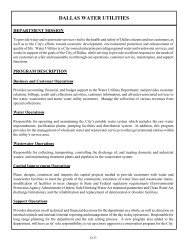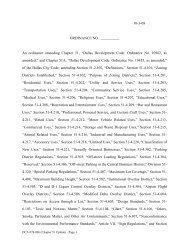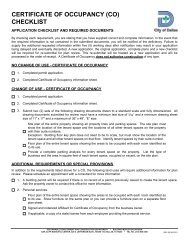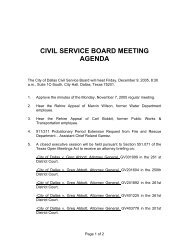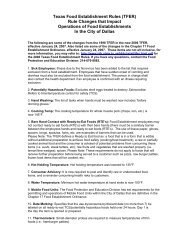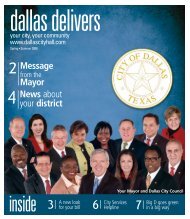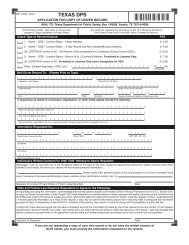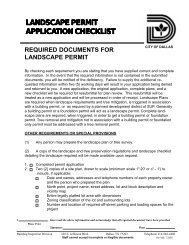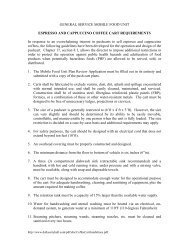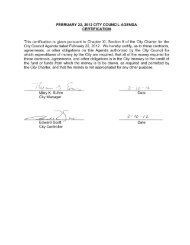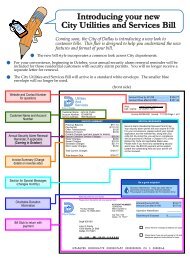fy 2012-13 proposed capital improvement budget - City of Dallas
fy 2012-13 proposed capital improvement budget - City of Dallas
fy 2012-13 proposed capital improvement budget - City of Dallas
Create successful ePaper yourself
Turn your PDF publications into a flip-book with our unique Google optimized e-Paper software.
PARK AND RECREATION CAPITAL IMPROVEMENTS<br />
Community Parks These parks are larger than Neighborhood Parks and<br />
usually comprise 15 to 100 acres and serve a 2-mile radius. These parks<br />
may include areas for intense recreation activity such as competitive sports,<br />
swimming, tennis, playgrounds, volleyball etc. There may also be passive<br />
recreation opportunities such as walking, viewing, sitting and picnicking.<br />
<strong>Dallas</strong> Arboretum Provides for the development at <strong>Dallas</strong> Arboretum in<br />
partnership with the <strong>Dallas</strong> Arboretum and Botanical Society.<br />
<strong>Dallas</strong> Zoo This category provides for development within the park and is<br />
<strong>of</strong>ten accomplished in partnership with the <strong>Dallas</strong> Zoological Society.<br />
Downtown Parks Provides for the development <strong>of</strong> parks within the Central<br />
Business District.<br />
Environmental Provides funding to address <strong>improvement</strong>s directly affecting<br />
the health and well-being <strong>of</strong> the citizens <strong>of</strong> <strong>Dallas</strong>.<br />
Erosion Control These projects employ a variety <strong>of</strong> engineering techniques<br />
to control erosion around creek, channel or lake banks. Erosion problems, if<br />
left unchecked, will cause damage to existing structures in the park and may<br />
create hazardous conditions.<br />
Fair Park Provides for the development <strong>of</strong> projects within Fair Park. These<br />
projects <strong>of</strong>ten are completed in partnership with the State Fair <strong>of</strong> Texas, Inc.<br />
or other institutions who have a stake in the development <strong>of</strong> the park.<br />
Hike and Bike Trails All-weather trail projects that encourage walking,<br />
bicycling, and other modes <strong>of</strong> transportation as an alternative to the<br />
automobile. These trails <strong>of</strong>fer sufficient width to accommodate bicyclists,<br />
pedestrians, and skaters, and are recommended under the North Central<br />
Texas Council <strong>of</strong> Government's (COG) Mobility 2025 Plan and the Texas<br />
Natural Resources Conservation Commission's (TNRCC) Emission<br />
Reduction Plan for the region.<br />
Historic Restoration These <strong>improvement</strong>s provide for the restoration and<br />
stabilization <strong>of</strong> historically significant park facilities, particularly those<br />
constructed during the 1930s Works Progress Administration era.<br />
Linear/Linkage These areas are built connections or natural corridors that<br />
link parks together. Typically, the linear park is developed for one or more<br />
modes <strong>of</strong> recreational travel such as walking, jogging, skating etc.<br />
Major Maintenance Provides repair and replacement <strong>of</strong> major building<br />
systems that typically cost more than $10,000 and provide timely and<br />
appropriate maintenance to protect the <strong>City</strong>'s general fund facility investment.<br />
This process ensures safe and usable facilities for citizens and staff, and<br />
maintains a positive image for the <strong>City</strong>. Examples <strong>of</strong> building systems<br />
include elevators, structural components, ro<strong>of</strong>s, HVAC, electrical, plumbing,<br />
and interior finishes.<br />
Major Park Facilities These <strong>improvement</strong>s provide for the development <strong>of</strong><br />
new park facilities or renovation <strong>of</strong> existing facilities at regional parks that<br />
provide citywide or regional services. Included are projects at Fair Park,<br />
<strong>Dallas</strong> Zoo, <strong>Dallas</strong> Nature Center, Katy Trail, Golf Courses, and the<br />
Arboretum.<br />
Metropolitan Park These parks are large facilities that service several<br />
communities. The parks range in size from 100-500 acres which serve the<br />
entire <strong>City</strong> and are natural areas or developed for a variety <strong>of</strong> outdoor<br />
recreation activities.<br />
Mini Park These parks are used to address limited, isolated or unique<br />
recreation needs <strong>of</strong> concentrated populations; usually 1 acre or less in size<br />
with less than ¼ mile service radius.<br />
Neighborhood Park Facilities These facilities provide for new recreation<br />
centers and additions to and renovations <strong>of</strong> existing recreation centers. The<br />
standard recreation center has program space and a full gymnasium. An<br />
addition typically consists <strong>of</strong> a large multi-purpose room. Reservation<br />
facilities are available to the public for rental for special events and functions.<br />
These parks are from 1 to 15 acres in size and service a ½ mile radius.<br />
Park Land Acquisition Provides funding for the acquisition <strong>of</strong> land for future<br />
park development.<br />
Playground Improvement Includes new playgrounds or replacement <strong>of</strong><br />
outdated playground equipment. These projects may also include<br />
replacement or installation <strong>of</strong> new groundcover material to ensure<br />
playground safety.<br />
393



